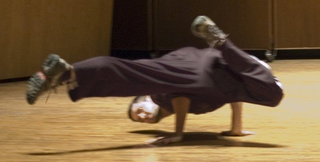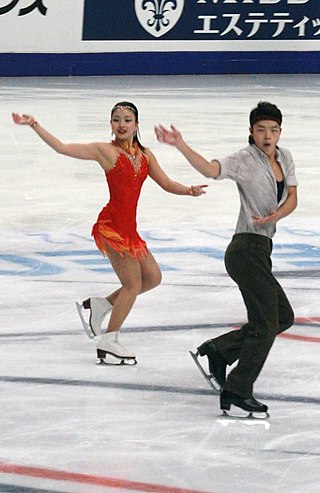
Spins are an element in figure skating in which the skater rotates, centered on a single point on the ice, while holding one or more body positions. They are performed by all disciplines of the sport, single skating, pair skating, and ice dance, and are a required element in most figure skating competitions. As The New York Times says, "While jumps look like sport, spins look more like art. While jumps provide the suspense, spins provide the scenery, but there is so much more to the scenery than most viewers have time or means to grasp". According to world champion and figure skating commentator Scott Hamilton, spins are often used "as breathing points or transitions to bigger things".
This is a list of dance terms that are not names of dances or types of dances. See List of dances and List of dance style categories for those.
Because ballet became formalized in France, a significant part of ballet terminology is in the French language.

Breakdancing or breaking, also called b-boying or b-girling (women), is a style of street dance originated by African Americans and Puerto Ricans in the Bronx.

The chassé is a dance step used in many dances in many variations. All variations are triple-step patterns of gliding character in a "step-together-step" pattern. The word came from ballet terminology.

The Windmill is a popular b-boying b-girling move. The breaker rolls their torso continuously in a circular path on the floor, across the upper chest/shoulders/back, while twirling their legs in a V-shape through the air.
The Swipe is one of the most recognizable power moves in b-boying. The b-boy or b-girl leans back, whips his or her arms to one side to touch the ground, and his or her legs follow closely behind, twisting 360 degrees to land on the ground once again. An example is the swipe performed by the character Samir in the movie Office Space.

Footwork is a martial arts and combat sports term for the general usage of the legs and feet in stand-up fighting. Footwork involves keeping balance, closing or furthering the distance, controlling spatial positioning, and/or creating additional momentum for strikes.

The float (turtle) is a b-boying move originally coming from basic Gymnastics alongside variants specifically the Turtle. Though it appears to demand great strength, the float actually requires balance above all because the breaker's weight is supported on the elbows which are firmly planted ("stabbed") into the lower abdomen near the anterior superior iliac spine.

A spin is a b-boying move that involves rotation of the breaker's body about some axis in contact with the ground. It is possible to perform a spin on virtually any part of the body, but bare skin often causes painful and spin-killing friction with the floor. To solve this problem, many breakers employ pieces of cloth or wear long clothing, pads, or caps. When the dancer uses his hands to aid in speeding up the spin, it is called tapping. A dancer may tap for a few rotations and then glide for subsequent rotations. Spins form an integral part of many breakers' routines, while others eschew them in favor of more complex-looking repeated movements, back and forth, after each rotation in a given direction.
A freestyle skateboarding trick is a trick performed with a skateboard while freestyle skateboarding. Some of these tricks are done in a stationary position, unlike many other skateboarding tricks. The keys to a good freestyle contest run are variety, difficulty, fluidity, and creativity. This is an incomplete list, which includes most notable tricks.
The Yemenite step is a dance step widely used in Jewish dancing and Israeli folk dancing. It originates from the dancing of Yemenite Jews.
The following is a glossary of figure skating terms, sorted alphabetically.

The 2-step, also known as Mini Swipe or Baby Swipe, is a footwork sequence in breakdance.
A step sequence is a required element in all four disciplines of figure skating, men's single skating, women's single skating, pair skating, and ice dance. Step sequences have been defined as "steps and turns in a pattern on the ice". Skaters earn the most points in step sequences by performing steps and movements with "flair and personality", by turning in both directions, by using one foot and then the other, and by including up and down movements.

Bachata is a style of social dance from the Dominican Republic which is now danced all over the world. It is connected with bachata music.

Tactics are very important to playing well in modern fencing and although technique is important in the sport, using an array of tactics will help fencers make the most of that technique.

Ice dance, a discipline of figure skating, has required elements that make up a well-balanced rhythm dance program and free dance program, which must be performed during competitions. They include: the dance lift, the dance spin, the step sequence, turn sequences, and choreographic elements. The elements must be performed in specific ways, as described by published communications by the International Skating Union (ISU), unless otherwise specified. The ISU has also provided a list of illegal movements.











